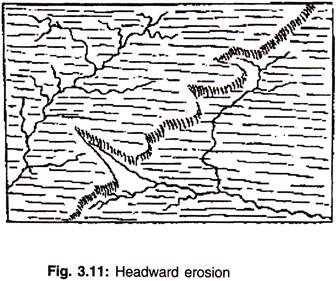ADVERTISEMENTS:
After reading this essay you will learn about the oxygen cycle.
The oxygen cycle is the biogeochemical cycle that describes the movement of oxygen within and between its three main reservoirs; the atmosphere (air), the biosphere (living things), and the lithosphere (Earth’s crust). The main driving factor of the oxygen cycle is photosynthesis, which is responsible for the modern Earth’s atmosphere and life. The amount of oxygen in and around the earth is fixed. But this oxygen is fed again and again through the world’s living systems in a never-ending circle called the oxygen cycle.
Our needs are just part of this cycle. The cycle involves a continual exchange of gases between the air and animals and plants. In a process called respiration, animals and plants take oxygen from air and give back carbon dioxide. In a process called photosynthesis, plants take carbon dioxide from air and water and give back oxygen. Respiration and photosynthesis are effectively opposite processes.
ADVERTISEMENTS:
Respiration is an oxidation reaction, which takes oxygen from the air or from water. Photosynthesis is a reduction reaction. It adds oxygen gas to the air. Enormous quantities of oxygen are taken in by plants and animals every day, and huge quantities of oxygen are returned to the air by plants. These amount exactly balance so that overall the amount of oxygen in the air stays the same.
Oxygen, like carbon and hydrogen, is a basic element of life. In addition, in the form of O3 ozone, it provides protection of life by filtering out the sun’s UV rays as they enter the stratosphere. In addition to constituting about 20% of the atmosphere, oxygen is ubiquitous. It also occurs in combination as oxides in the Earth’s crust and mantle, and as water in the oceans.
Early in the evolution of the Earth, oxygen is believed to have been released from water vapor by UV radiation and accumulated in the atmosphere as the hydrogen escaped into the earth’s gravity. Later, photosynthesis became a source of oxygen. Oxygen is also released as organic carbon in CHO, and gets buried in sediments. The role of oxygen in life is described in the unit on Biological Systems.
Oxygen is highly reactive. A colorless, odorless gas at ordinary temperatures, it turns to a bluish liquid at -183° C. Burning or combustion is essentially oxidation, or combination with atmospheric oxygen. Fig. 2.16 shows a very broad overview of oxygen cycling in nature. The environment of oxygen in numerous reactions makes it hard to present a complete picture.
ADVERTISEMENTS:
Oxygen is vital to us in many ways (beside the most obvious—for breathing). Water can dissolve oxygen and it is this dissolved oxygen that supports aquatic life. Oxygen is also needed for the decomposition of organic waste. Wastes from living organisms are “biodegradable” because there are aerobic bacteria that convert organic waste materials into stable inorganic materials. If enough oxygen is not available for these bacteria, for example, because of enormous quantities of wastes in a body of water, they die and anaerobic bacteria that do not need oxygen take over.
These bacteria change waste material into H2S and other poisonous and foul-smelling substances. For this reason, the content of biodegradable substances in waste waters is expressed by a special index called “biological oxygen demand” (BOD), representing the amount of oxygen needed by aerobic bacteria to decompose the waste.
